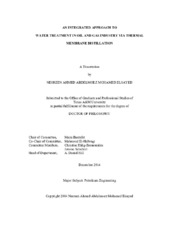| dc.contributor.advisor | Barrufet, Maria | |
| dc.contributor.advisor | El-Halwagi, Mahmoud | |
| dc.creator | Elsayed, Nesreen Ahmed Abdelmoez Mohamed | |
| dc.date.accessioned | 2015-04-28T15:31:03Z | |
| dc.date.available | 2016-12-01T06:36:16Z | |
| dc.date.created | 2014-12 | |
| dc.date.issued | 2014-10-14 | |
| dc.date.submitted | December 2014 | |
| dc.identifier.uri | https://hdl.handle.net/1969.1/153943 | |
| dc.description.abstract | This work is aimed at developing a systematic approach for designing treatment systems for wastewater streams resulting from upstream production and downstream processing of oil and gas systems. The approach will provide an optimum and integrated design to address the problem of the huge amounts of wastewater produced through either producing or processing the hydrocarbons using Thermal membrane distillation (TMD).
Thermal membrane distillation (TMD) is an emerging technology which is gaining an increasing level of interest in the area of high-purity separation especially in water treatment. It is driven primarily by heat which creates a vapor-pressure difference across a porous hydrophobic membrane. Hot produced water and excess low-level heat from industrial processes can be integrated with TMD and used to drive it. This transfer of heat also reduces the cooling utility load for the process. Therefore, dual heat-reduction benefits accrue as a result of this heat integration. Additionally, process wastewater and utility water may be treated using TMD then recycle/reused in the process and/or sold to external users.
In this work we introduce a process integration framework from the thermal coupling of TMD networks and industrial processes. First, a three-parameter model is developed to quantify the water flux through the membranes as a function of heat and temperature. The model is validated using experimental data for direct-contact membrane distillation (DCMD). Next, the transshipment model for heat integration is extended to account for the coupling of the process and the TMD network and the need to optimize the extent of heating for the TMD feed. A discretization approach is used to linearize the thermal-coupling constraints. The mathematical-programming formulation is solved to identify the optimal heat integration strategies within the process and with the TMD network. The program also determines the optimal temperature to which the TMD feed should be heated and the system design and specification.
Three different applications are introduced including three case studies. Each case study is solved to show the performance of the TMD when applied as standalone technology and when thermally coupled with the main process. For the case of standalone TMD the consumption of heating utilities is highly increased and affects the total cost of TMD and accordingly the decision of the treatment option. For the other case when all the heat needed by the TMD is provided by excess process heat or free source of heating, an interesting reduction is achieved in the total annualized cost of the TMD network. This reflects the significant value of thermal coupling. The results also demonstrate reducing of cooling load of the process and the creation of recycle/reuse opportunities for the treated wastewater. | en |
| dc.format.mimetype | application/pdf | |
| dc.language.iso | en | |
| dc.subject | Water desalination | en |
| dc.subject | Thermal membrane distillation | en |
| dc.subject | SAGD | en |
| dc.subject | Flowback | en |
| dc.title | An Itegrated Approach to Water Treatment in Oil and Gas Industry via Thermal Membrane Distillation | en |
| dc.type | Thesis | en |
| thesis.degree.department | Petroleum Engineering | en |
| thesis.degree.discipline | Petroleum Engineering | en |
| thesis.degree.grantor | Texas A & M University | en |
| thesis.degree.name | Doctor of Philosophy | en |
| thesis.degree.level | Doctoral | en |
| dc.contributor.committeeMember | Ehlig-Economides, Christine | |
| dc.contributor.committeeMember | Schubert, Jerome | |
| dc.type.material | text | en |
| dc.date.updated | 2015-04-28T15:31:03Z | |
| local.embargo.terms | 2016-12-01 | |
| local.etdauthor.orcid | 0000-0003-1383-5798 | |


